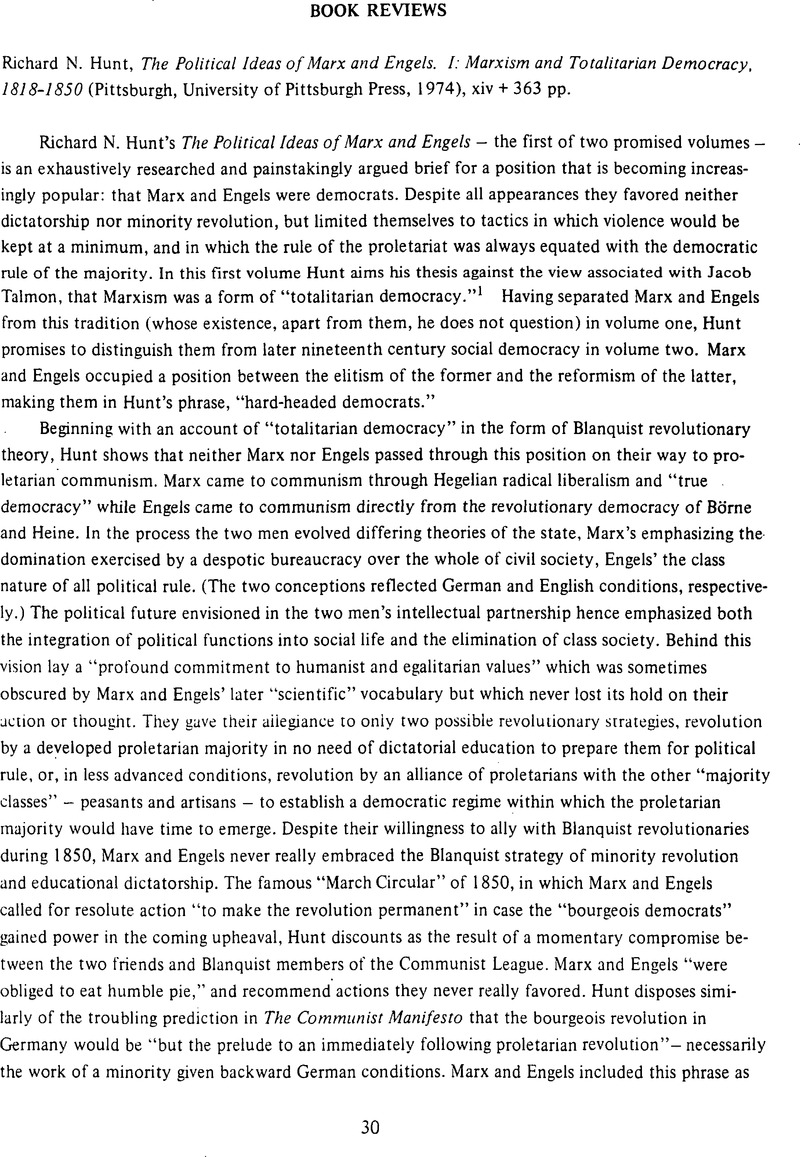No CrossRef data available.
Article contents
Richard N. Hunt, The Political Ideas of Marx and Engels. I: Marxism and Totalitarian Democracy, 1818–1850 (Pittsburgh, University of Pittsburgh Press, 1974), xiv + 363 pp.
Review products
Published online by Cambridge University Press: 16 December 2008
Abstract

- Type
- Reviews
- Information
- Copyright
- Copyright © International Labor and Working-Class History, Inc. 1975
References
NOTES
1. However. Talmon's book appeared in 1952, not 1960 as Hunt indicates. It is neither so recent nor so currently influential as Hunt's making it his starting point suggests.
2. Marx, Karl, “Toward the Critique of Hegel's Philosophy of Law: Introduction,” published in the Deutsch-Französische Jahrbücher early in 1844, and translated in Easton, Lloyd D. and Guddat, Kurt H., Writings of the Young Marx on Philosophy and Society (New York, 1967), 249–64Google Scholar. Cf. Hunt, 132. 178.
3. Hunt, 160. It should be pointed out in passing that Schapper at this time employed an idealist terminology whose differences with Marx Hunt ought not to ignore. To comment on Schapper's declaration that “When the revolution of the spirit now beginning has reached its end, the physical one will come by itself,” that “Schapper now seemed to share exactly Marx and Engels' conception of revolution” (158) does not reveal much sensitivity to Marx and Engels' concerns.
4. Cited in Marx, Karl and Engels, Frederick, The Revolution of 1848–49, Articles from the Neue Rheinische Zeitung. tr. by Ryzanskaya, S. and edited by Isaacs, Bernard, (Moscow and New York, 1972), 207Google Scholar.
5. Karl Marx and Frederick Engels, “Address of the Central Council to the Communist League,” in Marx and Engels, Selected Works in Two Volumes. (New York, International Publishers, n. d.) II. 154–68.
6. See Marx's letter to Engels of July 13. 1851. and Engels reply, July 20, in Marx-Engels, , Worke (Berlin, 1956 ff) vol. 27, pp. 278, 288Google Scholar.
7. The quote from Marx cited in Hunt. 218; for the Engels passage see Karl Marx, Selected Works in Two Volumes (New York, International Publishers, n. d.) II. 149.
8. Marx, Karl, “Marginal Notes to the Program of the German Workers' Party” (Critique of the Gotha Program), in Marx, and Engels, , Selected Works in One Volume (Moscow and New York, 1968), 332Google Scholar.
9. Marx, Karl, The Class Struggles in France (1848–1850) (New York, 1964), 138Google Scholar.
10. Ibid., 131
11. “Address of the Central Council.” ed. cit., 168.
12. Marx, The Class Struggles, 120.
13. See the minutes of the Central Council meeting of September 15, 1850, printed by Nicolaevsky, B., “Toward a History of the ‘Communist League’ 1847–52,” International Review of Social History 1 (1956), 234–52CrossRefGoogle Scholar. Marx said in the meeting that Schapper's policy of seeking government control in the next revolution amounted to “declaring all the petty bourgeois to be proletarians, and thus de facto to represent the petty bourgeoisie and not the proletariat.” (249). It is true of course that Marx took a dim view of Schapper's brand of revolutionary violence, but Marx identified Schapper, not himself, with the democrats (whose “terrorist phrases” he had referred to in the March Circular), whereas Hunt does the opposite.
14. See Writings of the Young Marx, ed. Easton and Guddat, 368.
15. Minutes of Sept. 15th meeting, Nicolaevsky, 251.




